
|
. |
Home Cet article en français Women in colonial times Ecrivaines depuis les années 1960 |
| Women's challenge to convention |
| The hidden face of 20th century colonial life in Africa |
 The engagement of European women in 20th century colonial life can
only be understood in the context of the socio-cultural elements that framed
its expression and limited its influence. Officially, Africa's colonisation was led by men. Women's intervention was merely "helping the civilizing mission of their male companion"[1]. As argued by Marie-Louise Comeliau in her Guide for
the "Modern Eve", when bound for the Congo in 1945, Africa was not suitable
for free and unattached women.[2].
Women writers of the colonial era are expressing in a variety of ways the ill effects of this sexist baggage, yet the overall
picture proposed in their writings testifies to an involvement
in colonial life far more diverse than suggested by Marie-Louise Comeliau. Irrespective of their
marital status, the women inscribed in the books at hand did not dwell on their
"helplessness" or "weakness", but on their achievements. Admittedly, the
selection of authors mentioned below is rather sketchy, spreads over more then fifty years,
refers to the whole of Black Africa and is not restricted to French writing.
That does not permit broad generalisation but it shows, however, that "African
history is rich in strong and independent women"[3] who provide an alternative body of texts from the
20th century colonial era and calls for both a different depiction
of the past and the debunking of a few myths.
The engagement of European women in 20th century colonial life can
only be understood in the context of the socio-cultural elements that framed
its expression and limited its influence. Officially, Africa's colonisation was led by men. Women's intervention was merely "helping the civilizing mission of their male companion"[1]. As argued by Marie-Louise Comeliau in her Guide for
the "Modern Eve", when bound for the Congo in 1945, Africa was not suitable
for free and unattached women.[2].
Women writers of the colonial era are expressing in a variety of ways the ill effects of this sexist baggage, yet the overall
picture proposed in their writings testifies to an involvement
in colonial life far more diverse than suggested by Marie-Louise Comeliau. Irrespective of their
marital status, the women inscribed in the books at hand did not dwell on their
"helplessness" or "weakness", but on their achievements. Admittedly, the
selection of authors mentioned below is rather sketchy, spreads over more then fifty years,
refers to the whole of Black Africa and is not restricted to French writing.
That does not permit broad generalisation but it shows, however, that "African
history is rich in strong and independent women"[3] who provide an alternative body of texts from the
20th century colonial era and calls for both a different depiction
of the past and the debunking of a few myths.
Let me begin with a first example. A recent article by Faranirina V. Rajaonah dealing with textbooks used in Madagascar's schools analyses a short text by Suzanne Andriamahanina and Marcel Ratsima, telling the story of Niry and her young brother Nary. The two children have been invited to a first flight by their uncle, a pilot with the national airline, and when the little girl says she wants to become a pilot, her brother and the men of the family do not take her ambition seriously. It is not possible for you to fly, Nary argues, "the proof of it is that women have been unheard of in this career.[4]" It is of course a mistake as Africa had its women pilots, but their achievements did not make it to the history books and they never became role models. How could they have had an influence on the thoughts of two Malagasy schoolchildren at the end of the 20th century ? how could they have encouraged them to "break with diehard stereotypes"[5] ? how could they have spurred a "new representation of women and the their relationship with men"[6] ? The answer is pretty clear : it was not possible : Niry and Nary could not have guessed that women who were contemporaries of their great-grand-mother were already criss-crossing the African sky, many decades before they were even born.
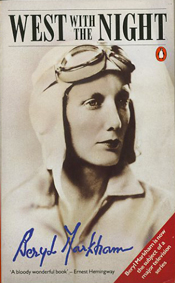 Aviation does not rate very highly in canonical literature and it is,
by-and-large reduced to a few volumes devoted to the pioneers of the
Aéropostale, thus the little impact of the autobiography of
Kenyan aviator Beryl Markham, titled Vers l'Ouest avec la nuit[7]. This book deserves better as it bears witness
to the success of the author in her conquest of a male dominated – and well
guarded – occupation. Beryl Markham learnt to fly in 1931 in Nairobi, a city
where she settled with her father in 1906 at the age of four. Her
autobiography published in 1942 devotes many chapters to her activities as a
professional pilot :
Aviation does not rate very highly in canonical literature and it is,
by-and-large reduced to a few volumes devoted to the pioneers of the
Aéropostale, thus the little impact of the autobiography of
Kenyan aviator Beryl Markham, titled Vers l'Ouest avec la nuit[7]. This book deserves better as it bears witness
to the success of the author in her conquest of a male dominated – and well
guarded – occupation. Beryl Markham learnt to fly in 1931 in Nairobi, a city
where she settled with her father in 1906 at the age of four. Her
autobiography published in 1942 devotes many chapters to her activities as a
professional pilot :
-
Tom taught me in a DH Gipsy Moth, at first, and her propeller beat the sunrise
silence of the Athi Plains to shreds and scraps. We swung over the hills and
over the town and back again, and I saw how a man can be master of a craft, and
how a craft can be master of an element. I saw the alchemy of perspective
reduce my world, and all my other life, to grains in a cup. I learned to watch,
to put my trust in hands other than mine. And I learned to wander. I learned
what every dreaming child needs to know – that no horizon is so far that you
cannot get above it or beyond it. These I learned at once.[8]
Some one thousand flying hours later, Beryl Markham was awarded a professional "B" licence that allowed her to carry passengers, mail, freight and whatever had to be carried across the continent. She says, "Often we left the Nairobi Airfield just after dawn – Tom perhaps bound for Abyssinia and I for the Anglo-Egyptian Sudan, Tanganyika, Northern Rhodesia, or wherever somebody would pay me to go."[9] On a few occasions Beryl Markham flew to England and she became the first woman to fly solo across the Atlantic from east to west in 1936.
Beryl Markham's flying experience was second to none, but she was not the only woman pilot that could have been given as an example to Niry and her brother Nary in order to better their knowledge of the past. Black American Bessie Coleman qualified as a pilot even earlier. She became the first Black women pilot in 1921, graduating in France, as American authorities did not allow her to learn to fly because of her race and gender[10].
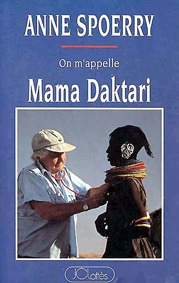 The life of French Doctor Anne Spoerry might have been mentioned as well.
Released from Ravensbrück in 1945, she left for Ethiopia in 1948 and moved
to Kenya in the early fifties. She was hoping to find work there but was
greeted with the the prejudices common amongst colonial administrations :
The life of French Doctor Anne Spoerry might have been mentioned as well.
Released from Ravensbrück in 1945, she left for Ethiopia in 1948 and moved
to Kenya in the early fifties. She was hoping to find work there but was
greeted with the the prejudices common amongst colonial administrations :
– A woman doctor, never : unmarried on top of that. Her presence would only unsettle the young administrators of the region.
– That was final[11].
Kenya's prejudices against women, as experienced firsthand by Anne Spoerry, was a textbook illustration of the prevailing colonial wisdom espoused by Marie-Louise Comeliau in her Guide dealing with the Congo. Nevertheless, Anne Spoerry eventually managed to cut through administrative red tape and prejudice and find a position as a rural doctor in the small Kenyan community of Ol Kalou, a place located at an altitude of 2500m.
It is hard to refrain from telling the full life story of this country doctor roving over the region in her "203" French car; but it is as a women pilot that she has been subpoenaed here. One has to jump to the year 1963 to learn about her decision to learn to fly. Shortly after Kenyan independence, she had to end her work at Ol Kalou. This decision necessitated a reorientation of her career :
-
I took my first flying lesson on June 23, 1963, she wrote in her autobiography.
I always had been tempted to learn to fly, in the same way I liked steering
boats, riding horses or driving cars. All that for the same reason, i.e., to
tame an animal or to master an instrument in order to conquer a new area of
freedom. So far, a lack of time and opportunities had held me back, but the
changes that threw Kenya into upheaval pushed me to take action [...]
I was quite depressed and at first flying was an outlet for my anguish, a soothing activity. At the time, I did not know that I would join the flying doctors of Michael Wood, but I felt intuitively that I had to find a new direction for my life and that becoming a pilot might help[13].
What follows in Anne Spoerry's life is legendary : she bought her first plane in 1964, joined the flying doctors of the American Medical and Research Foundation (AMREF) the following year and continued working for this organization for more than thirty years.
Bessie Coleman, Beryl Markham, Anne Spoerry, Anne Conti – a French oceanographer who spent ten years exploring the swamps between Senegal and the Ivory Coast in the 1940s and 1950s in order to survey fishing grounds along the African coast.[14] – and many other women deliberately challenged, head on, the preserve of male dominated occupations in order to free themselves from the yoke of social expectation. However, strong-willed individuals commited to social change have not been the only ones to bring about change and to challenge colonial wisdom. Married women who followed the man they loved to Africa, "as a matter of course"[15], had also to take a stand, for a variety of reasons, when they found themselves cut off from "the strong element they were supposed to lean upon". These women did not choose to challenge gender inequality outright. But the vanishing of their companion offered them no alternative other than to take charge of their own destiny. They had to break away from the supporting act assigned to women if they did not want to be shipped back to Europe. Although unwillingly, they found themselves on the same side as the suspicious and ill accepted "independent" women. Left with no choice but to fight, they developed new alliances, types of relationships with others and prerogatives. Take a few examples:
Mary Patten, firstly : As mentioned above, she was the owner of the house rented by Anne Spoerry. How little we know of her life; we are learning that in 1959, at the time of her death, Mary Patten lived alone (widowed perhaps ? we do not know, but it is her godson who inherited her property). Could this aloneness be an explanation for her friendly attitude toward the new woman doctor in spite officialdom's disapproval ? Being in charge of her property and free to befriend whoever she pleased, she did not need the consent of anyone to make a young women doctor feel welcome. Financial independence can also mean freedom of the mind.
 Danish author Karen Blixen provides a second example. Her well-known
autobiographical novel Out of Africa[16] and her correspondence allow us to move from hypothesis
to fact. Karen Blixen arrived in Kenya in 1914 where she married, in style,
the Baronet Bror von Blixen-Finecke soon after she set foot in the country. A
letter to her mother relates the event:
Danish author Karen Blixen provides a second example. Her well-known
autobiographical novel Out of Africa[16] and her correspondence allow us to move from hypothesis
to fact. Karen Blixen arrived in Kenya in 1914 where she married, in style,
the Baronet Bror von Blixen-Finecke soon after she set foot in the country. A
letter to her mother relates the event:
-
Bror was in Mombassa to meet me and it was wonderful to be with someone one
feels one belongs with again [...]
... at eleven o'clock we were married, with Sjøgren, Prince Vilhelm, Bostrøm and Lewenhaupt standing as witnesses; it was extremely easy and simple and only took ten minutes at most. Then we drove out by ricksha to have lunch with Hobley, who had married us; he had a really delightful villa right on the shore, – and from there to the train, a special train for Prince Vilhelm, with the Governor's private dining car [...]
There was a surprise in store for me when we arrived at the farm. All the thousand boys were drawn up in ranks and after a really ear-splitting welcome they closed ranks and came up to the house with us[17].
Unfortunately for the couple, the honeymoon was short-lived as Karen Blixen soon realised that her husband was not cut out to be a businessman and lacked the necessary skills to run the vast coffee plantation, just outside Nairobi, bought by her family. Furthermore, she discovered he had numerous affairs and that she had been infected with syphilis. Her relationship with Bror deteriorated even further when she fell in love with local personality Denys Finch Hatton. In 1921, under pressure from her family, who had invested a considerable amount of money in the plantation, she had to take formal charge of the estate and her husband was sacked from the business. That lead to the permanent separation of the couple and eventually their divorce in 1925. In contrast with Beryl Markham and Anne Spoerry, Karen Blixen's breaking away from matrimony and taking charge of a vast rural property in the heart of Africa did not stem from her deliberate attempt to challenge social convention, nor did it reflect any hunger for emancipation. It was rather the unsolicited outcome of the shortcomings of her husband who was a womaniser, a squanderer and an incompetent business manager. Yet, in the end, Karen Blixen's lot was no different from that of unmarried professional women and her achievements contributed no less to invalidate the myth of the weak colonial woman dependent on a strong, close masculine support for survival.
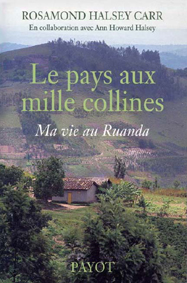 The story of American born Rosamond Halsey Carr, one generation later, is
similar. After meeting the explorer and safari hunter Kenneth Carr who was
touring America, Rosamond Halsey Carr married him in 1942. In 1949, the couple
decided to leave for Rwanda/Burundi where Kenneth Carr had in mind to embark on
mineral exploration. Unfortunately for him, he was not granted permission to
start his project and ended up in the Congo as the manager of a pyrethrum
plantation – i.e., a plantation specialising in the production of a daisy-like
flower used to make insecticide. As was the case with Karen Blixen, Rosamond
Halsey Carr's husband grew rapidly tired of his marital and managerial duties,
much to the sorrow of his wife :
The story of American born Rosamond Halsey Carr, one generation later, is
similar. After meeting the explorer and safari hunter Kenneth Carr who was
touring America, Rosamond Halsey Carr married him in 1942. In 1949, the couple
decided to leave for Rwanda/Burundi where Kenneth Carr had in mind to embark on
mineral exploration. Unfortunately for him, he was not granted permission to
start his project and ended up in the Congo as the manager of a pyrethrum
plantation – i.e., a plantation specialising in the production of a daisy-like
flower used to make insecticide. As was the case with Karen Blixen, Rosamond
Halsey Carr's husband grew rapidly tired of his marital and managerial duties,
much to the sorrow of his wife :
My initial curiosity and timidity toward a culture so different from my own quickly gave way to feelings of genuine affection and respect. Many of the dearest and most important friendships in my life have been among the African people.
My expectations of a happy home-life in a true partnership with my husband were dashed almost from the start. Kenneth was away much of the time – either on safari or in search of adventure and new opportunities – leaving me alone for weeks at a stretch. I was frightened and lonely, and spent long hours weeping inconsolably and feeling terribly sorry for myself. In time, though – and as a matter of necessity – I managed to pull myself together and began to accompany Cleophas on his daily tours of inspection. [...] I gradually learned to speak Swahili, and as time went by, I learned a great deal about running a plantation[18].
Let down by her husband, Rosamond Halsey Carr had few alternative but to take charge of her own destiny. It was not by choice that she immersed herself in the running of a plantation; rather, it was out of necessity. Her subsequent decision to run a pyrethrum plantation on her own, away from the family farm, was a milestone in her painful transition from emotional dependency to independence. The opportunity of freeing herself from a stifling family life happened when a neighbour decided to take an extended holiday in Europe and she accepted an offer to run the estate in his absence. That meant managing a place employing 280 people and producing tons of pyrethrum flower. As one could guess, Kenneth Carr found the idea ludicrous, but it was too late for him to change his wife's decision :
-
Kenneth was livid that I would even consider such an idea. He said it was
improper and unseemly, and that I was utterly incapable of handling such an
enterprise on my own. But my mind was made up. Perhaps, I reasoned, a short
separation would do us both some good[19].
Rosamond Halsey Carr's successful stand-in did not relieve family tensions; thus her final separation from her husband a few years later and, after many arduous years, the purchase of her own plantation in Rwanda in 1955. Unlike many colonial owners, she remained in the country after independence, adapting to new demands and held on to her property until the massacres that plunged Rwanda into a bloodbath in 1994. Like many unsung women of great courage, her achievements have been so far by-passed by history because she did not fit colonial stereotypes : she showed most convincingly that some women had an impact on colonial society and were not a mere support of their companion's "civilizing mission".
The achievements of a woman pilot and those of a plantation owner-manager were difficult to accept in a colonial society, one biased against women's independence and their ability to tackle so called "men's jobs". So too was the wandering of women bound for Africa for no other reason than to discover the continent on their own terms. For the colonial administration, travelling to the colonies meant engaging in a God-blessed civilizing mission according to a well-defined division of labour along gender, class and race divides. Adventurous women travelling solo to Africa – with no commitment other than tiptoeing through the countryside armed only with their courage, notebooks and cameras – were socially and morally unacceptable. Venturing alone and without a purpose in those "treacherous" parts was seen as an aberration and everyone would ask, "How on earth a poor women abandoned in the midst of such an hostile environment could even think she could get away with such a folly : even more so, if she is not protected by a strong escort of well-armed men experienced in handling the natives ?" However, many little-remembered books show, not only that many women dreamed of exploring the vast expanses of the African continent, but, more importantly, that a good number did manage to do so, overcoming all the social, familial and administrative impediments in taking the road – like Mary H. Kingsley who travelled thousand of miles alone across West Africa in the 19th century. What these women travellers with no "specific mission", no vested interest and no ulterior motive, lacked in social recognition, they were compensated by a freedom to cross boundaries and to escape the tunnel vision of colonial officialdom, thus the interest of their work[20].
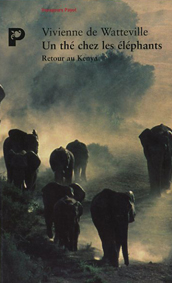 Vivienne de Watteville and her book titled Speak to the earth[21] – published in 1935 – provide a worthy
illustration of this freedom of thought. Vivienne was the daughter to an
upper-class English mother and a Swiss father who had been killed by a lion in
Kenya a few years ealier. She was in her twenties, single, rich and independent
when she decided to return to Africa for a year-long expedition. Yet, instead
of stepping into her father's shoes and leaving for the then customary big game
hunt – that sustained the ivory trade and supplied a vast number of specimens
to overseas museums of Natural History –, she decided to follow her dream and to
discover Africa differently : that is, attempting to befriend the animals her
father had been so keen to kill.
Vivienne de Watteville and her book titled Speak to the earth[21] – published in 1935 – provide a worthy
illustration of this freedom of thought. Vivienne was the daughter to an
upper-class English mother and a Swiss father who had been killed by a lion in
Kenya a few years ealier. She was in her twenties, single, rich and independent
when she decided to return to Africa for a year-long expedition. Yet, instead
of stepping into her father's shoes and leaving for the then customary big game
hunt – that sustained the ivory trade and supplied a vast number of specimens
to overseas museums of Natural History –, she decided to follow her dream and to
discover Africa differently : that is, attempting to befriend the animals her
father had been so keen to kill.
-
Before, [...] I had gone with my father to make a collection of the fauna of East Africa for the Berne Museum. This had been his dream [...] But my own private dream had always been to go into the wild unarmed and, in some unforeseen way, to win the friendship of the beasts. [...]
And now I was going back in my own way.[22].
This willingness to establish a new kind of relationship with the African fauna was to become one major tourist attraction a few decades later[23], but when Vivienne de Watteville mentioned her plans to her entourage, she was considered raving mad. Except for her grandmother who, the narrator says, "would unfailingly catch my own enthousiasm and sigh: 'Ah, if only I were forty years younger, I'd go with you!'"[24], everyone around her tried to discourage her and her ambition to rub her hand on the back of an elephant just attracted scorn. When she arrived in Nairobi, her welcoming was no different. The personal Secretary of the Governor harshly criticised her plans and stated unequivocally that he would do everything in his power to stop her from going anywhere – although, in the end, succumbing to her charm he gave her his full support. Women of the colony were not supportive either, as can be gauged from the narrator's account of her meeting with two unannounced visitors:
-
[...] two strange women, motoring to Tanganyika, caught me in camp unawares, and ingenously explained that they had heard of me from some natives at the ford, and wanted "to see what I looked like."
I cannot think why it seemed to me an inescapable duty to ask them to tea. I quickly regretted it, for their duty appeared to them even more urgent, and they took me to task and scolded me so roundly for the dangers I ran and my misguided choice of occupation that I felt sitting between the Red and White Queens. I should not have minded that, but when they were rude about my tame rhino, my ears went right back.[25].
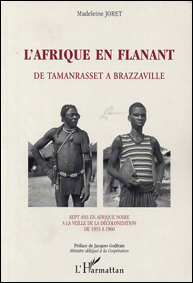 Outcasts in the White community, European single women travellers were also
misunderstood by the Black African and Arab population as their lack of male
protection looked like an "affront to local traditions" that spurned single
women. The preface of L'Afrique en flânant. De Paris à
Tamarasset[26] – the first volume of a
travelogue by French globetrotter Madeleine Joret who crossed the Sahara in the
early 1950s and spent some ten years in Africa subsequently – provides comments
that would have rung true in most parts of Africa :
Outcasts in the White community, European single women travellers were also
misunderstood by the Black African and Arab population as their lack of male
protection looked like an "affront to local traditions" that spurned single
women. The preface of L'Afrique en flânant. De Paris à
Tamarasset[26] – the first volume of a
travelogue by French globetrotter Madeleine Joret who crossed the Sahara in the
early 1950s and spent some ten years in Africa subsequently – provides comments
that would have rung true in most parts of Africa :
Quickly, she understood that the mere fact of being a woman, travelling alone and bereft of male protection was, to the Muslims of the Algerian mountains, an affront, even a kind of bravado as her status was an implicit condemnation of their own religious, social and familial system. These men's failure to understand her was complete [...][27]
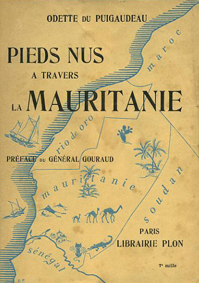 Pieds nus à travers la Mauritanie[28], by Odette du Puigaudeau – another French
traveller who recounts her lengthy crossing of Western Sahara with her friend
Marion Sénones a generation before Madeleine Joret – also mentioned the
surprise of local elders encountering White women travelling alone :
Pieds nus à travers la Mauritanie[28], by Odette du Puigaudeau – another French
traveller who recounts her lengthy crossing of Western Sahara with her friend
Marion Sénones a generation before Madeleine Joret – also mentioned the
surprise of local elders encountering White women travelling alone :
-
Very soon after our arrival, Odette du Puigaudeau says,
Abdallahi-ould-Cheikh-Sida invited us under his tent – that could be seen from
the post, at the top of a sand dune nearby [...]
Sitting on the right hand side, as requested by etiquette, Abdallahi was waiting for us in the centre of a respectful Court.
[...]
During this speech, Abdallahi was watching us with an air of amusement. [...] France is quite mighty if, now, she allows women to travel across this bush that were, in year past, the theatre of so much unrest... And now, we have French women who write like marabouts and travel like warriors ! ! La illah ill Allah !...[29]
The determination of women travellers, of course, did not owe anything to France and her colonial administrators who were, on the whole, strongly determined to curtail, by all means, "unproductive" wandering in Africa. The success of "women adventurers" was solely due to their own efforts, willpower, strength of character and a conviction that it was possible to establish new forms of relationships with Africa that were not built on brute force, violence and intimidation. Misunderstood by both sides, they were not concerned with religious preoccupations, economic pursuits or territorial conquests, but rather peaceful contact based on a genuine interest in and respect of "Other". Their presence on the ground, more than their skills and discourse, was a direct challenge to the convictions of political and religious leaders of all complexions who strongly believed in the abiding values of traditions. In a decisive but non-threatening manner, they were undermining age-old taboos and signalling new ways of thinking. Gender equality was in train, not to be halted.
The writings of women travellers who stood apart from colonial wisdom had an added advantage insomuch they neither attempt to condemn nor to convince the reader on ideological, financial or political grounds. They only meant to share experiences, observations and feelings with the readers. In this regard, aforementioned Odette du Puigaudeau stands as good an example as any other. During her long journey across the Mauritanian desert – she covered 5500 km including 2900 on camel-back – she could not escape noticing the ruthless exploitation of the population. France was mercilessly taxing the locals and promises for help in terms of health and education had not been kept. The sorry state of the once fiercely independent region she discovers was reflected in the bitterness of local elders who felt duped by the French pledge to "pacify the country" and to help. As Abdallahi-ould-Cheikh-Sida told the young woman :
-
Mauritania is at the same time the colony which is the poorest and the most
heavily taxed [...] the trade of gum and dates is crushed by taxation yet, in
days gone by, the French promised to abide by koranic custom that states that
such a tax should not be higher than one fortieth of the capital.
[...]
I have too much respect for France, he added, to believe that such a grand nation could merely conquer a country and collect taxes without extending the benefice of its civilisation to those who have put all their hope in it[30].
Odette du Puigaudeau was undoubtedly impressed by the people she meets. Although she travelled with the French Governor's permission, she discovered the other side of the picture and empathised with her interlocutors; yet she did not take sides, thus providing her readers an opportunity to make up their own mind, even if that did not suit everyone, as she discovered:
-
One can avoid looters, deal with the Maures, the wild animals, the sun and the
sandstorms, but one can neither escape from the civilian who accuses the
informant to be militaristic nor from the military who accuse her of being too
sympathetic towards the civilians[31].
The fact of arguing the importance of the women travellers who landed in Africa on their own, with no specific mission, does not mean that the legacy of women arriving on the continent with a well defined purpose is of secondary importance. It is not. Neither category should be ignored, but both have to be understood in the context of their time that explains not only much about individual's behaviour, but also the driving force behind their actions.
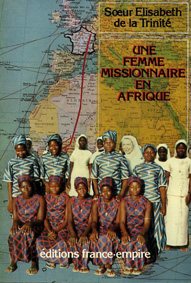 Personal accounts by Missionary Sisters offer a good example. With few or no
exceptions, they show complete submissiveness to the Church Fathers, little
appreciation of traditional beliefs and relentless attempts to convert Africa
to Christianity. Thus the temptation to overlook the missionary zeal of
thousands of Missionary Sisters – who operated under the benevolent protection
of colonial authorities – and to brush aside their books in the belief that we
would lose little in leaving them out of the picture. This would be a mistake
as these books have their importance, if only because they give access to a
side of colonial history that differs from official records. A book such as
Une femme missionnaire en Afrique[32]
by Sister Elisabeth de la Trinité is a case in point. This autobiography
highlights the author's fifty years with the Mission in Algeria, Mali, Burkina
Faso, Rwanda Guinea and eventually Congo. It provides ample details of Sister
Elisabeth's life, but more importantly it also reveals her Order's and her own
vision of colonial society from an idiosyncratic women missionary's
perspective. In that sense, her autobiography is invaluable. Above and beyond
religious considerations, this book – and others of a similar nature – widens
our understanding of the role of women in colonial times and allows us to go
past the "official" history of the Colonies : a history that focuses mainly
on the achievements of a few "heroic" figures, leaving us at the mercy of
stereotypical ideas and propaganda. Take for example Marie-Louise Comeliau's
portrayal of women missionaries in her Guide : in line with her apology for
female subservience to the male, she argues that the Sisters could not live far
from a Mission because "the Fathers were the strong element against which the
weakness and helplessness of the Sisters could lean "[33].
Personal accounts by Missionary Sisters offer a good example. With few or no
exceptions, they show complete submissiveness to the Church Fathers, little
appreciation of traditional beliefs and relentless attempts to convert Africa
to Christianity. Thus the temptation to overlook the missionary zeal of
thousands of Missionary Sisters – who operated under the benevolent protection
of colonial authorities – and to brush aside their books in the belief that we
would lose little in leaving them out of the picture. This would be a mistake
as these books have their importance, if only because they give access to a
side of colonial history that differs from official records. A book such as
Une femme missionnaire en Afrique[32]
by Sister Elisabeth de la Trinité is a case in point. This autobiography
highlights the author's fifty years with the Mission in Algeria, Mali, Burkina
Faso, Rwanda Guinea and eventually Congo. It provides ample details of Sister
Elisabeth's life, but more importantly it also reveals her Order's and her own
vision of colonial society from an idiosyncratic women missionary's
perspective. In that sense, her autobiography is invaluable. Above and beyond
religious considerations, this book – and others of a similar nature – widens
our understanding of the role of women in colonial times and allows us to go
past the "official" history of the Colonies : a history that focuses mainly
on the achievements of a few "heroic" figures, leaving us at the mercy of
stereotypical ideas and propaganda. Take for example Marie-Louise Comeliau's
portrayal of women missionaries in her Guide : in line with her apology for
female subservience to the male, she argues that the Sisters could not live far
from a Mission because "the Fathers were the strong element against which the
weakness and helplessness of the Sisters could lean "[33].
No better denial of that fallacious exposition of the Sisters' presumed weakness and reliance on male help can be found than in a text dealing with Reverend Mother Marie-Michelle Dédié – who worked as a Missionary in Senegal and the Congo from 1882 to 1931 – and her relationship with the "strong element" of the Mission to which she was sent by her Order :
-
At the mission, the highly gendered roles of the European church pertained, and
were enforced by the authoritarian Monsignor Augouard, who ran his mission like
a political kingdom. At their convent community within the larger mission, the
Sisters organised the work with women and girls, but on certain matters, they
had to give an accounting to the male authorities. Their permissible sphere of
action was domestically defined. For Reverend Mother Marie, crossing boundaries
determined by the bishop was fraught with problems. Her letters give glimpses
of the situation, as she shared her dilemmas with the Mother-General. For
example, the colonial administration was a male domain, and to approach it
independently with requests for help – usually granted – could risk the
bishop's wrath. In 1898, when she needed funds to take a sick Sister to the
coast and appealed to the administration – having been turned down by the
bishop who said she needed to find the means herself – she wrote of Augouard's
displeasure and how she had to go "on her knees like a child" to beg his
forgiveness. Two years later, while Augouard was on a trip upriver, she
accepted land from the administration to enlarge the convent property. But on
his return, she reported, he was incensed that such action had been taken
without his consent, that the land had been put in the name of the Cluny
Sisters, and that the administration seemed to grant the nuns' requests but not
his[34].
Obviously, invoking the "weakness and helplessness of the Sisters" in order to justify their presence next to a Mission under male authority is only a ploy designed to hide the Fathers' need for domestic help and to absolve Bishops such as Augouard who were bullying female Missionary Sisters in order to take full advantage of their work and influence in the local community[35]. The books and documents Reverend Mother Marie-Michelle Dédié or Sister Elisabeth de la Trinité left behind are important because they give us a chance to enter history by a small side door and to discover fascinating anecdotal evidence that challenges the "Grand Narrative" proposed by the Colonial Fathers. They are also essential as they reveal the complexity of society that can only be understood in the context of the contradictory forces and power struggles that determined people's destiny at every echelon of colonial life.
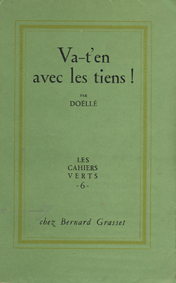 The contribution to knowledge of women journalists arriving on the continent
with the well defined purpose of exposing some of these struggles is also
interesting but, as was the case with missionary writing, it is essential to
put their investigation of and interest in African issues in the context of
their personal and professional pursuits. Their books are often less
interesting for what they say about Africa than for what they tell us about the
author's preoccupations, values and genuine interest – or lack thereof – in
African/colonial society. The rather obscure reasons that led Christine Garnier
to publish Va-t'en avec les tiens ! [36] in 1951 under the
pseudonym Doellé is a case in point. This novel is excellent from a
literary point of view. It deals with the issue of hybridity in a colonial
context that advocates racial segregation while turning a blind eye to
inter-racial relationships. However, the origins of the book, the story of its
publication and the reasons that lead Christine Garnier to deal with the issue
of cultural hybridity and self-representation – that would become such a major
issue later on – is unclear. According to Christine Garnier's autobiography[37], she went to Africa in 1947 at the
invitation of an old friend who lived in Togo with her husband, a colonial
doctor. In order to cover part of her travel cost, Christine Garnier turned to
the "Old M. Payot" who agreed to sign a contract for a book on sorcery and
fetishism. But once in Togo, it was the story of the young nurse Doellé
that took her fancy and she returned to France with a manuscript telling her
story. Editor Bernard Grasset, sniffing out a possible literary success,
modified the manuscript with Christine Garnier in order to satisfy French
readers' taste and expectations and published the novel under the name of
Doellé. Did Doellé really exist ? Christine Garnier said
"yes"[38], but this life story that was written by a journalist and
revised by the editor with no consultation with the presumed "author" cannot be
considered as a genuine autobiography : it smacks of identity theft rather than
a bona fide personal account. Interesting from a purely literary point of view,
the dark side of this text is also important as it exposes common editorial
scheming that controlled the kind of books offered to readers and, by
association, the latters' perception of life in the colonies.
The contribution to knowledge of women journalists arriving on the continent
with the well defined purpose of exposing some of these struggles is also
interesting but, as was the case with missionary writing, it is essential to
put their investigation of and interest in African issues in the context of
their personal and professional pursuits. Their books are often less
interesting for what they say about Africa than for what they tell us about the
author's preoccupations, values and genuine interest – or lack thereof – in
African/colonial society. The rather obscure reasons that led Christine Garnier
to publish Va-t'en avec les tiens ! [36] in 1951 under the
pseudonym Doellé is a case in point. This novel is excellent from a
literary point of view. It deals with the issue of hybridity in a colonial
context that advocates racial segregation while turning a blind eye to
inter-racial relationships. However, the origins of the book, the story of its
publication and the reasons that lead Christine Garnier to deal with the issue
of cultural hybridity and self-representation – that would become such a major
issue later on – is unclear. According to Christine Garnier's autobiography[37], she went to Africa in 1947 at the
invitation of an old friend who lived in Togo with her husband, a colonial
doctor. In order to cover part of her travel cost, Christine Garnier turned to
the "Old M. Payot" who agreed to sign a contract for a book on sorcery and
fetishism. But once in Togo, it was the story of the young nurse Doellé
that took her fancy and she returned to France with a manuscript telling her
story. Editor Bernard Grasset, sniffing out a possible literary success,
modified the manuscript with Christine Garnier in order to satisfy French
readers' taste and expectations and published the novel under the name of
Doellé. Did Doellé really exist ? Christine Garnier said
"yes"[38], but this life story that was written by a journalist and
revised by the editor with no consultation with the presumed "author" cannot be
considered as a genuine autobiography : it smacks of identity theft rather than
a bona fide personal account. Interesting from a purely literary point of view,
the dark side of this text is also important as it exposes common editorial
scheming that controlled the kind of books offered to readers and, by
association, the latters' perception of life in the colonies.
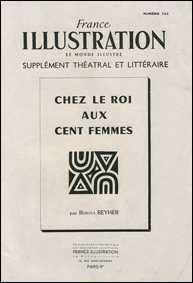 The publication of The Fon and His Hundred Wives by American journalist
Rebecca Reyer aimed also at shaping the readers' mind, but in contrast to the
previous book, it did not "massage" the truth to suit readers' expectations.
Following the success of her first book dealing with polygamy in South Africa
(published in 1948[39]), Rebecca Reyer
embarked on a sequel showing "that this wasn't just a custom limited to South
Africa"[40]. As the author said subsequently in an interview:
The publication of The Fon and His Hundred Wives by American journalist
Rebecca Reyer aimed also at shaping the readers' mind, but in contrast to the
previous book, it did not "massage" the truth to suit readers' expectations.
Following the success of her first book dealing with polygamy in South Africa
(published in 1948[39]), Rebecca Reyer
embarked on a sequel showing "that this wasn't just a custom limited to South
Africa"[40]. As the author said subsequently in an interview:
The St. Joan's Feminist Alliance of England petitioned the United Nations, claiming that the Cameroons and some other African countries were under United Nations jurisdiction as trustee territories and that they were, according to the Human Rights Charter, obligated to observe human rights; that polygamy and forced marriage were contrary to human rights, and that they wanted an immediate investigation. These women's organisations forced the United Nations to at least discuss the matter. When this story and polygamy was raised on the floor of the United Nations, I listened to some of the discussion. The men under whose jurisdiction it came, couldn't think of a bigger joke. They just all guffawed.
I couldn't get those Cameroon women out of my mind. I felt that I had to go, and do another study on polygamy to prove to the United Nations that the young women were not acquiescent, that girls and women were running away. Since the UN had agreed to go to the Cameroons to make an investigation, I wanted to make one, too[41].
Rebecca Reyer, years earlier, had written articles featuring Sita Gandhi, Mrs. Paton and many other young South African women of every race and colour. When she set out for Cameroon, Rebecca Reyer, with no ulterior motive, looked to build upon her previous work. She was just keen to expose a situation that was not taken seriously by the authorities and her interest in the fate of Cameroonian women was not faked. She thought it was proper to fight on the side of the victims of sexist attitudes that not only limited women's freedom, but also restricted their ability to be heard. Half a century later, the mechanism that led the coloniser to take over the voice of the colonised and to speak in their name has been exposed: but it is nevertheless important go beyond a blunt dismissal of all White women's voices and to differentiate between colonial attempts aimed at depriving African population of their own voice in order to silence opposition and individuals' endeavours to give back their voice to the oppressed. In denouncing polygamy, it is fair to say that Rebecca Reyer addressed an issue which was not of direct concern to her, yet her challenge to patriarchal power is aimed at both traditional and Western societies. It revealed that at every level of social interaction, some men of influence were not taking women's plight and claims seriously. In 1928, French journalist Louise Faure-Favier had challenged male sexism and racism in arguing that "the Fathers of French literary critique declaring that Blacks could not be writers of genius" was as worthless as "the Fathers of the Church who proclaimed that women did not have a soul"[42]. One generation later, Rebecca Reyer was showing that the Fathers of international politics who considered the fate of the Fon and his wives a joke were no better than their alter-ego and their attitude just as bad. Conjointly, one has also to acknowledge that Rebecca Reyer was spared the wrath of colonial authorities for her unsolicited comments and meddling in the colony's affairs because her book did not challenge white colonial hegemony as she cast her eyes on an aspect of traditional life that colonial powers considered backward.
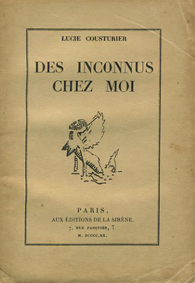 Colonial authorities were less amused and conciliatory when it came to women
taking upon themselves to openly criticise the evils of European presence in
Africa. As in previous centuries, the writers who indulged in such a critique
were mercilessly censured and most of their books are still to re-emerge from
oblivion.
Colonial authorities were less amused and conciliatory when it came to women
taking upon themselves to openly criticise the evils of European presence in
Africa. As in previous centuries, the writers who indulged in such a critique
were mercilessly censured and most of their books are still to re-emerge from
oblivion.
French woman Lucie Cousturier illustrates the point. She was a painter and had discovered colonial society by instalments: first, her brother-in-law became the Governor of a French Colony around the turn of the 19th century, then, during World War I, a large party of "Tirailleurs sénégalais" were stationed next to her house in the South of France and eventually she was sent on a mission to Africa by the French Government in 1921 and 1922. Her acquaintance with the tirailleurs sénégalais she met and befriended between 1916 an 1919 is detailed in her first book Des Inconnus chez moi[43]. This autobiography tells how she met and later developed friendly relations with individuals who were widely different from the stereotypical images of Black and African people[44]. Her mission to Africa a few years later convinced her further that French attitudes towards the Africans in French Western Africa (A.O.F.) did not rise to the "high standard of morality"[45] claimed by France and that interracial relationships were dogged by the influence of both stereotypes and essentialist scientific theories disparaging the non-Europeans[46]. Sharing the views of her contemporary Louise Faure-Favier, she discovered that the Fathers of colonialism were mistaken : that the denigrating of Black Africans on the basis of race was in fact the outcome of a "logic of profit", typical of all oppresive regime and non egalitarian societies :
-
In the district's main towns, when people kept telling me that the Blacks were
liars, thieves, indolent, ungrateful, these words were losing their meaning as
I heard them oft repeated : I remembered too clearly hearing them – the very
same words – during my childhood from the mouths of both my old Auntie speaking
of her maids and my Uncle with regard to his workers [...]
And my Uncle was saying about his White workers that they were "a nasty race" ungrateful, backward, a rotten race. And no one disagreed[47].
Lucie Cousturier's analysis of colonial society – that underlined the weakness of the colonial system, its poor achievements, its abuses and the major shift in policy required to engage in a meaningful collaboration between France and her African colonies – was not to the liking of French ministerial elites and it is hardly a surprise to learn that her final report somehow vanished from French colonial archives in Aix[48] while the "Official reaction by the Director of the Political and Administrative Affairs of the General Government of the A.O.F." was archived. This "reaction" provides a hint as to Lucie Cousturier's criticism of French colonisation :
-
In her report, Mme Lucie COUSTURIER does not hesitate to claim that "the
Whites making money in the colonies are giving nothing back, they live there in
a sordid greediness and take with them all the wealth they accumulated in
order to spend it in their respective capitals. White colonials, even with the
best of intentions, and in spite of themselves, can only contribute to this
politic of depletion [...]
The Blacks have been overwhelmed by this coalition of ill-intentioned profiteers, thus giving up all effort in the face of a rapacious White man whose avidity is robbing them of all their profit[49].
The fate of Lucie Cousturier's report is unclear, but the conclusion of the civil servant in charge of its evaluation leaves little doubts as to its final destination :
-
the politic and economic conclusions of Mme Lucie Cousturier can only be seen
as expressing her own personal theory, one that would be deplorable to spread
in mainland France and very dangerous if it was to take root amongst the
natives of our colonies[50].
Thus, a couple of years later, the two volumes of Mes inconnus chez eux, published by Lucie Cousturier in order to tell the story of her journey to Africa took the road to obscurity in spite of some positive comments by contemporaries, such as celebrated author René Maran. Like in the 19th century, literary survival or disappearance was due to the manoeuvres of a politico-economic and administrative elite protecting their interest rather than literary values. The censure of Lucie Cousturier in the 1920s is easy to understand, yet the reason for her to remain in semi-obscurity almost a century later is less obvious. One can only share Roger Little's bewilderment : "How could the writing of Lucie Cousturier, how could the woman herself sink into such complete oblivion ?"[51].
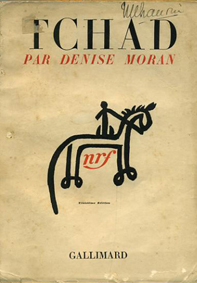 The disappearance of Denise (Moran) Savineau's report – another critical
analysis of French colonialism – a generation after the "loss" of Lucie
Cousturier's and the sidelining of her book Tchad[52] (1934) – illustrates the pitiless censure that
systematically silenced those who denounced the "logic of profit" that
distorted interpersonal and inter-racial relationships in the colonies,
tarnishing French ideals of liberty equality and fraternity in the process.
Denise Morand's argument was especially damaging as it was based on an
insider's examination of the issues. "Over three years, Denise Morand said, I
lived in three stations in the bush, I sojourned twice in the main town – under
two different Governors –, I was the acting head of the Office of Political and
Administrative Affairs and I explored the archives"[53]. In asking Denise Morand to take charge of an important
colonial office as acting head, the hierarchy certainly did not expect her to
go beyond day-to-day matters until such time as a proper head could deal with
important issues; nor were they anticipating that she would review
administrative blunders and become highly critical of the administration that
promoted her. As mentioned in Tchad's introduction, even close friends
were arguing against her rocking the boat:
The disappearance of Denise (Moran) Savineau's report – another critical
analysis of French colonialism – a generation after the "loss" of Lucie
Cousturier's and the sidelining of her book Tchad[52] (1934) – illustrates the pitiless censure that
systematically silenced those who denounced the "logic of profit" that
distorted interpersonal and inter-racial relationships in the colonies,
tarnishing French ideals of liberty equality and fraternity in the process.
Denise Morand's argument was especially damaging as it was based on an
insider's examination of the issues. "Over three years, Denise Morand said, I
lived in three stations in the bush, I sojourned twice in the main town – under
two different Governors –, I was the acting head of the Office of Political and
Administrative Affairs and I explored the archives"[53]. In asking Denise Morand to take charge of an important
colonial office as acting head, the hierarchy certainly did not expect her to
go beyond day-to-day matters until such time as a proper head could deal with
important issues; nor were they anticipating that she would review
administrative blunders and become highly critical of the administration that
promoted her. As mentioned in Tchad's introduction, even close friends
were arguing against her rocking the boat:
– Wow ! an honest civil servant told me – one of the few who do not deny the dramatic situation – you are going to say everything ! That will do much harm.
– To whom ?
– To the civil service, to colonisation, to France... Come on, you are French and should feel a sense of solidarity with the French ... you are White and should feel solidarity with the Whites ...
– Against the Blacks ?
– In the very interest of the Blacks ... Think what will happen to this colony once you have proven that we are... neglecting it : England, Germany, Italy, all ferocious exploiters, America, possibly, which is lynching her Negroes, will claim it to themselves ... Can't you feel the sensitivity of the issue... Come on, your superiors trusted you, they gave you this job...[54]
The publication of Tchad should have been more then enough to exclude Denise Moran Savineau from all colonial circles forever, however, the rise to power of the Popular Front in France in 1936 gave her an opportunity to expand her observation of the colonies when she was appointed to a fact-finding mission by her friend Marcel de Coppet, the new general Governor of the A.O.F.; de Coppet was, as critic Claire Griffiths said, "sympathetic to the new left-leaning philosophy, which espoused the view that a flourishing colonial empire was built on understanding and co-operation between the coloniser and the colonised, not on coercion and repression of local populations, methods which had characterised many colonial projects in Equatorial Africa in the 1920s and 30s".[55] Within a year, an 800 page report on family and women's condition in A.O.F was presented to Governor de Coppet, but Denise Moran's findings and suggestions did not translate into concrete measures. Mentalities had changed little from the previous generation when Lucie Cousturier was arguing that "a few months of vigorous education would have been necessary before [White colonists] had learned to say hello to a Black first, to let him have their seat, stand aside, to forego one's own desires and undue haste to let him pass with a gracious, "after you"[56]. Re-education was not to be. The Government of the Popular Front was running out of time. A new Government was elected and the new team in charge of the colonies shelved Savineau's report with such perfunctory haste that it was only very recently that it was "rediscovered" in Dakar, in the National Archives of Senegal.
Like all the women writers mentioned above, Denise Savineau did not question the tenets of the European "civilizing mission" of Africa, yet, as argued by Claire Griffiths, she was "fiercely critical of colonial exploitation"[57]. The meshing of these two elements which represent the two faces of the same oppression is now well known, but to Lucie Cousturier, Denise Savineau and many other women writers of previous generations, "civilizing" and "exploiting" were concepts that were mutually opposed. The engagement of European women in 20th century colonial enterprise can only be understood in the context of their time and it would be wrong, I believe, to limit our evaluation of their achievements against a set of beliefs that were ill-understood or of no concern to them at the time. In the eyes of many, individual engagement had to conform to social norms. For some others, on the contrary, it was an opportunity to explore the world outside conventions, to discover new ways of relating to others and to understand oneself better. Present attitudes are a product of this blend of reactionary attitudes and challenging ideas, thus the importance to call together and listen to all the players who have shaped past societies, irrespective of gender, if we are to understand the world as it has been and as it will be when handed over to the Nirys and the Narys of the 21st century.
Jean-Marie Volet
2007
| Women in colonial times. Keeping track of women writing |
Notes
[1] Catherine Jacques et Valérie Piette. "L'union des femmes coloniales (1923-1940" in Anne Hugon, Histoire des femmes en situation coloniale: Afrique et Asie, XXe siècle. Paris: Karthala, 2004, p.101.
[2] Marie-Louise Comeliau. Demain coloniale
! Anvers: Editions Coloniale Zaïre, 1945.
-
"If she gets the opportunity to do so, the modern Eve will follow the man she
loves to Africa, as a matter of course.
But there is more to it.
Used to taking up male jobs in Europe, somewhat quietly, she is quite ready to do the same in the colony : Eve, even single, dreams of pitching her tent under the tropical sky.
Is it possible for a women alone ?
To this question, the State answers in its nice adminstrative style : except for the social workers and possibly nurses, there is no other career open to women in Africa where their presence is not welcome if they are single." (p.70, my translation).
[3] Rosamond Halsey Carr. Land of a thousand hills. My life in Rwanda. Le pays aux mille collines. [1999]. Penguin, Compass Press large print, 2000, p.57.
[4] Faranirina V. Rajaonah. "Féminin, masculin ? Manuels de lecture d'enseignantes malgaches (1970-2000)" in Anne Hugon, Histoire des femmes en situation coloniale: Afrique et Asie, XXe siècle. Paris: Karthala, 2004, p.218.
[5] Lucie Cousturier. [1925] Mes inconnus chez eux, Vol.2. Paris: L'Harmattan, Autrement Mêmes, 2003, Presentation by Roger Little, p.219.
[6] Rajaonah. "Féminin, masculin ?, p.229.
[7] Beryl Markham. West with the Night.
[1942]. London: Penguin, 1988.
Beryl Markham's life was featured in a mini television series in 1988 under the
title "Shadow on the Sun".
[8] Markham. West with the Night, p.163.
[9] Markham. West with the Night, p.168.
[10] "Elizabeth 'Bessie' Coleman (1893-1926)" The Pioneers [Sighted 21 September 2007].
[11] Spoerry. On m'appelle Mama Daktari, pp.85-86.
[12] Spoerry. On m'appelle Mama Daktari, p.86.
[13] Spoerry. On m'appelle Mama
Daktari, p.127.
It is also interesting to note that the example of another woman pilot might
have inspired her to learn to fly : "I also knew June Sutherland who was
honoured by the Queen for her activities during the war in Congo. Flying her
plane, she was operating from makeshift landing strips, right in the middle of
the combat zone and evacuated distressed women and children to Rwanda; she
saved a great many of them. It was her who took me to Loyangalani and Lake
Turkana for the first time, in 1961. This flight had been awsome and it may
well be at that time that I seriously considered flying on my own." Spoerry,
On m'appelle Mama Daktari, p.135. (My translation).
[14] Anita Conti. Géants des mers chaudes. [1957]. Paris: Payot, 2002.
[15] Comeliau. Demain coloniale, p.70.
[16] Isak Dinesen (the pseudonym of Danish Baroness Karen von Blixen-Finecke). Out of Africa. London, 1937.
Karen Blixen's life was featured in a movie in 1985 under the title "Out of Africa".
[17] Karen Blixen. Letters from Africa 1914-1931. London: Picador, 1983, p.2.
[18] Rosamond Halsey Carr. "Land of a thousand hills. My life in Rwanda", Compass Press, 1999, pp.49-50.
[19] Halsey Carr. "Land of a thousand hills, p.56.
[20] For example, in her introduction of Chez les pygmées (Paris: Editions Berger-Levrault, 1933), O. de Labrouhe wrote : « Not at all, my guide answered, sure of himself. This woman is only coming to us in order to observe how we live, how we eat and how we sleep; she is neither an administrator, nor a doctor or a Reverend Father, she is nothing, just a women passing by with no intent on foisting anything on us", pp.5-6.
[21] Vivienne de Watteville. Speak to the earth. Wanderings and reflections amongst elephants and mountains. New York: Harrison Smith and Robert Haas, 1935.
[22] de Watteville. Speak to the earth, pp.4-5.
[23] Dian Fossey, Jane Goodall and other women would build, in a far more radical manner, this association between human and the animals in subsequent generations. Furthermore, the second half of the 20th century was marked by a decisive shift from tourists' big game slaughter to a new game-friendly photographic safari.
[24] de Watteville. Speak to the earth, p.4
[25] de Watteville. Speak to the earth, pp.160-161.
[26] Madeleine Joret. L'Afrique en flânant. De Paris à Tamarasset. Paris: Nouvelles éditions Debresse, 1966.
[27] J.C. Frœlich. "Préface" in Madeleine Joret. L'Afrique en flânant, p.15.
[28] Odette du Puigaudeau. Pieds nus à travers la Mauritanie. Paris: Plon, 1936.
[29] du Puigaudeau. Pieds nus à travers la Mauritanie, pp.92-93.
[30] du Puigaudeau. Pieds nus à travers la Mauritanie, pp.99, 101.
[31] du Puigaudeau. Pieds nus à travers la Mauritanie, pp.vii-viii.
[32] Sœur Elisabeth de la Trinité.
Une femme missionnaire en Afrique. Paris: Editions France-Empire,
1983.
This title is only one of the many books testifying to missionnary work by
Sisters in Africa. Other titles include De la Côte des esclaves aux
Rives du Nil, published in 1921 by the Sisters of Notre-Dame des
Apôtre in Lyons; 11 mois en Afrique du Sud : Journal de voyage by
the Missionary Sisters of the Holy Family in Bordeaux, in 1939, etc.
[33] Comeliau. Demain coloniale !, p.71.
[34] Phyllis M. Martin, "Celebrating the Ordinary: Church, Empire and Gender in the Life of Mère Marie-Michelle Dèdiè (Senegal, Congo, 1882-1931)" in Gender & History, Vol.16, No.2, August 2004, pp.295-296.
[35] "Sister Maxima is to repair the linen of the Community and the socks of the Fathers. Each week they bring us 7-8 pairs with holes that need repair. Monsignor sends his laundry on Monday and Wednesday afternoons". Phyllis M. Martin, "Celebrating the Ordinary, p.296.
[36] Doellé. Va-t'en avec les tiens ! Paris: Bernard Grasset, 1951.
[37] Christine Garnier. Jusqu'où voient mes yeux. Paris: Laffont, 1975, p.65.
[38] Garnier. Jusqu'où voient mes yeux, p.86.
[39] Rebecca Hourwich Reyher. Zulu Woman: The Life Story of Christina Sibiya [1948] New York: The Feminist Press, 1999. Written on the basis of interviews conducted in 1934.
[40] "The Fon and His Hundred Wives". Online Archives of California. [Sighted 28 September 2007].
[41] "The Fon and His Hundred Wives". Online Archives of California.
[42] Lettre de Louise Faure-Favier adressée au rédacteur en chef de la Dépêche Africaine. Louise Faure-Favier. Blanche et Noir. [1928]. Paris: L'Harmattan. Coll. Autrement même, 2006. Présentation Roger Little et Laurent Freitas, p.xxviii.
[43] Lucie Cousturier. Des Inconnus chez moi. Paris: Editions de la Sirène, 1920.
[44] It is interesting to note that a similar encounter that occurred during World War II can be found in Hélène de Gobineau, Noblesse d'Afrique. Paris: Fasquelle Editeurs, 1946.
[45] "Lettre de la Direction des Affaires Politiques et Administrative du gouvernement général de l'O.A.F." reproduite dans Lucie Cousturier, Mes inconnus chez eux, Vol.2, Paris: L'Harmattan, Autrement Mêmes, 2003 p.173.
[46] In an address to the French Parliament in 1885, Jules Ferry argued that it was the duty of France to "civilize inferior races" and his idea gathered considerable support from all manner of men : intellectuals, scientists and church leaders were very keen to support France's occupation of her African colonies. Clemenceau's dissenting voice, alerting Ferry to the danger of "labelling another man or civilisation as inferior", was brushed aside and, early in the 20th century there were very few people expressing doubts about the "benefits" of colonisation. A century later, France has not yet come to terms with her colonial past and the heirs of discredited sciences such as phrenology, craniology and the like continue to propagate ideas of the inferiority of Black races. A recent article by J. Philippe Rushton and Arthur R. Jensen titled "Thirty years of research on race differences in cognitive ability" Psychology, Public Policy, and Law, Vol. 11, No. 2, 2005, pp.235-294, is but one sorry example.
[47] Extract cited in the official reaction to Lucie Cousturier's report by a French colonial civil servant in 1924. (Lucie Cousturier's report has disappeared from the Archives), in Lucie Cousturier, [1925] Mes inconnus chez eux, Vol.2. Paris: L'Harmattan, Autrement Mêmes, 2003. Présentation de Roger Little. p.178.
[48] Note by Roger Little in Cousturier. Mes inconnus chez eux. Vol.1, p.xvii.
[49] "Lettre inédite de la Direction des Affaires Politiques et Administratives du gouvernement général de l'A.O.F. adressée à Monsieur le Ministre des Colonies" [1924], in Cousturier. Mes inconnus chez eux. Vol.2, p.174.
[50] Extract cited in the official reaction to Lucie Cousturier'report, in Lucie Cousturier, [1925] Mes inconnus chez eux, Vol. 2, p.178.
[51] Little in Cousturier, Mes inconnus chez eux. Vol.1, p.vi.
[52] Denise Moran. Tchad. Paris: Gallimard, 1934.
[53] Moran. Tchad, p.10.
[54] Moran. Tchad, p.11.
[55] Claire Griffiths. "Introduction", The Savineau Archive (My translation) [Sighted 30 Septembre]. [Reedition in the collection Autrement Mêmes. Denise Savineau, La Famille en A.O.F. : condition de la femme. Rapport inédit, Paris: L'Harmattan, 2007. Presentation by Claire Griffiths].
[56] Cousturier. Mes inconnus chez eux, Vol.1, p.4.
[56] Griffiths. "Introduction", The Savineau Archive.
Editor ([email protected])
The University of Western Australia/French
Created: 4 November 2007
Modified: 13 December 2007
https://aflit.arts.uwa.edu.au/colonies_20e_eng.html